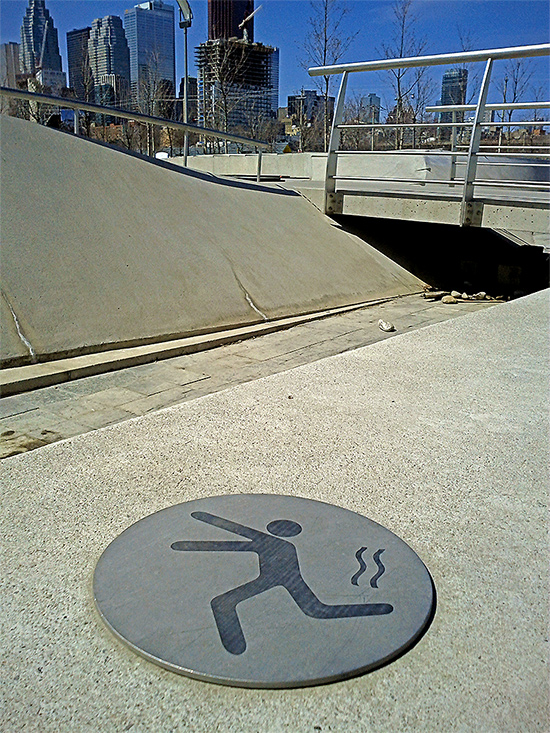I attended FlashInTO last night. The event bills itself as a “Toronto Flash User Group”, a monthly gathering of anyone interested in Adobe Flash and related technologies. I hadn’t attended in well over a year because the turnouts were becoming depressingly low, probably due to the previous subterranean location in Kensington Market, the regular mid-week date, and the exclusive availability of overpriced bottled beer and very little in the way of anything else.
Still, I thought, I’d give it another try – schmooze a bit, maybe chat about SocialCastr, and just see what was happening out there in the world of Flash and AIR. After all, Adobe recently released its roadmap for the Flash runtime, and just a couple of days ago announced even more news surrounding upcoming features and new pricing models. If anything, one might think that such topics would at the very least have been brought up at some point during the evening.
Well, one would be wrong. In fact, the entire evening was dominated by topics such as Unity, and HTML5, and ending with a shameless Apple love-in with literally not one mention of Flash. At all.
The “Emerging technologies in the real world” topic was interesting enough, with Demi Kandylis describing how his company used Unity to produce an interactive shadow puppet display for Sapporo, the Japanese beer maker. Demi’s team happened to use Unity, a 3D engine that can also be used to output to Flash, which could have become an interesting launchpad to at least mention some of the interesting work being done with Flash and 3D. But no mention of Flash, of course. Not even a hint.
The next presentation was part of what I see as the ongoing, and frankly insane push to get everyone to develop in HTML5. Here, Ken Peleshok demonstrated Adobe Edge, now in its 5th version and still able to perform only basic animations of the kind that Flash was capable of 15 years ago. The demonstration was pretty much a failure as Ken couldn’t get basic animations going with his code, but there was plenty of Apple-wielding supporters standing to the side exclaiming, “just you wait!” There was certainly enough opportunity to at least draw parallels to Flash animation, but of course that was never brought up. But why would anyone want to discuss Flash at an event called FlashInTO?!
I had to walk out on the final panel discussion because it turned into one of the most disgustingly overt Apple advertisements I’d ever witnessed, not to mention the conclusions that the panelists came to. The Apple logo featured prominently in every slide along with the panelists’ children, and everyone took the opportunity to casually wave around their iPads, Macs, or whatever piece of Apple hardware they were carrying to show that, yes, they were just the coolest people ever and could be trusted to deliver unbiased and reasoned opinions. Simon Conlin, the founder of FlashInTO (and later Flash In The Can…see below), started off by saying, “This isn’t supposed to be an advertisement for Apple or anything…”, and then motioned to the front of his laptop with the glowing Apple logo just to drive the point home before starting the accompanying slide show of panelists’ kids brandishing Apple hardware, often with the company’s logo as the primary focus and the kids in the corner of the images. Most of the time the kids weren’t in the picture at all, it was just photos of iPads, iPhones, and other iDevices.
Despite this end-of-night panel being billed as “A look at apps for kids, what’s good, what’s bad and much more”, there was literally one app that was shown while the discussion centered entirely around the “brilliance” of Apple’s marketing and design. And once again, not even a passing mention of Flash, Flash Builder, Catalyst, or any of the other Flash-related products that could easily have been incorporated into the discussion. Even Adobe wasn’t mentioned…it was a complete Apple circle jerk.
Believe it or not, though, the couple of overpriced pints I had downed allowed me to stomach things up until that point; it was only when the conversation turned to, “What the youth of today can teach us” that I packed it in. Once again with all attention on how Apple was genius for doing so, the panel began discussing how we, as software developers, should be tailoring our apps towards infants. After all, kids are completely uninhibited and have no preconceived notions about interacting with hardware or software, and so we should all be striving to dumb down our own products and make them as basic and infantile as possible. That way everyone could use what we produce without any real learning curve or impediments. And wouldn’t it be a good idea to cripple device functionality through our software to ensure that people only use our software when, how, why, and where we want them to?
I was this close to standing up and reminding them how their device-weaned spawn don’t have the wherewithal to keep their hands off of hot stoves or not run out into traffic (maybe that’s why adults think for a few moments before adorably mashing $800 devices with ball-peen hammers), but it was clear that they were really only into publicly masturbating to Apple propaganda and rhetoric. When, at some point in the past I’d mentioned that Applites offer up their firstborn to Steve Jobs, I thought I was only exaggerating – clearly I was wrong.
And just to drive home the point of the evening, a draw was held for tickets to this year’s FITC. That’s Flash In The Can, if you’ve never been. I haven’t, mostly because the tickets are ridiculously priced, and partially because even when I might’ve had a chance to attend, people who had deigned to call me their friend ended up attending, on free tickets, with other “friends” who had absolutely no interest in Flash, and without even mentioning the event until I found out about it accidentally afterwards. And that the FITC was held directly across from the street where I worked at the time just helped to drive that screw in a little deeper. Then there was the childish crap they pulled and subsequently tried to cover up using threats and intimidation, that just completed the picture of what kinds of people self-avowed Applites really are. Not all, of course – you may have an iDevice right now — but be aware that going down the Apple path almost always invariably ends up leading out of the asshole of one thing or another.
But while FITC of the past was actually about Flash, look at the lineup of topics for this year’s FLASH In The Can: HTML5 • Online Video • Kinect Hacking • Javascript • OOP • WebGL • OpenFrameworks. • CSS3 • Starling • jQuery • Flash Stage 3D • Augmented Reality • Digital Art • Robotlegs 2.0 + much more!
Out of the 80 or so presentations, five mention Flash. And these are: “Deep Dive in the Flash Platform Roadmap”, “Flash and HTML5″, “Moving Forward with Flash (or Not?)”, “OpenFrameworks 101 for Flash Developers”, “Tangled: HTML5 <video> and Flash”. In effect, that’s one presentation on the Flash Platform Roadmap I’d mentioned earlier, one presentation for beginner Flash developers, and three about how you should be abandoning Flash for HTML5 hype.
And just in case you had any doubt about their dedication to Flash, the only Flash element on the FITC website is the banner, FlashInTO has no Flash elements whatsoever.
Yeah, this is what things have come to. The word “ridiculous” doesn’t even begin to cover it, and although I tried not to make this into an Apple-bashing post, it’s unavoidable considering how it’s flaunted in everyone’s face so openly and readily; exclusively, even. And I can’t help but wonder when it’ll stop. What will it take for people to notice this insanity?







